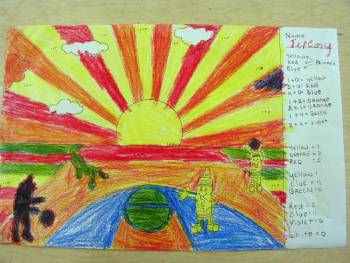 Shop On-Line at the Art of Essex
Shop On-Line at the Art of Essex
|
Lesson
Plan: Color By Numbers
Teacher: Mr. Essex Garner,
Saint Joseph Catholic School, Jefferson City, Missouri
Cooperating Teacher: Mrs. Suzy Weber
Unit: Making Art – Use of Color and Blending Techniques - math integration.
Grade Level: Elementary and Middle School (K through 4th Grades)
- Adaptable to higher grades.
Missouri Standards for Teacher Education Programs
(MoSTEP)
1.2.2.2 Strengthens prior knowledge with new ideas.
1.2.1.4 Engages students in the methods of inquiry used in the
subject(s).
1.2.2.3 Encourages student responsibility.
1.2.5.2 Engages students in active learning that promotes the
development of critical thinking, problem solving, and performance
capabilities.
Standards:
Performance Indicators:
1.2.6.2 Manages
time, space, transitions, and activities effectively.
1.2.9.2 Uses
resources available for professional development.
Color
By Numbers: Essex Garner
Objective Students will
be working on three goals: 1) Using only primary colors to make secondary
colors from basic color theory, 2) Use blending and mixing techniques to create
new colors; they can only bring three colors to class (Red, Yellow and Blue)
and create with their own hands new colors and enjoy working on the crayon
basketball players.
Supplies Needed Only the three basic primary crayons (Red, Yellow and Blue). Note: Do not use colors like indigo blue, or different shades of yellow or red. This project works much better if you only use the true base primary colors
Introduction: Begin talking to the students about their prior knowledge of colors and associate those colors with different things in the every day life. Explain how color effects moods, and how they see these colors everyday, and everywhere. Also associate this technique with beginning painting.
Attached to this lesson plan is a scan of three versions of this particular game. 8 ½ x 14 paper. You can make this on the copy machine. The math problems associated with this project can be adapted per grade level. Yellow = 1, Red = 2, Orange = 3, Blue = 4, Green = 5, Blue = White have a value of = 0.
Using
this math formula all Primary and Secondary Colors can be covered by the
student. Especially the lower grades, this will enhance their ability to
understand color blending and will inevitably help them in mixing colors when
they start painting.

|
1 + 0 = 1 Yellow |





